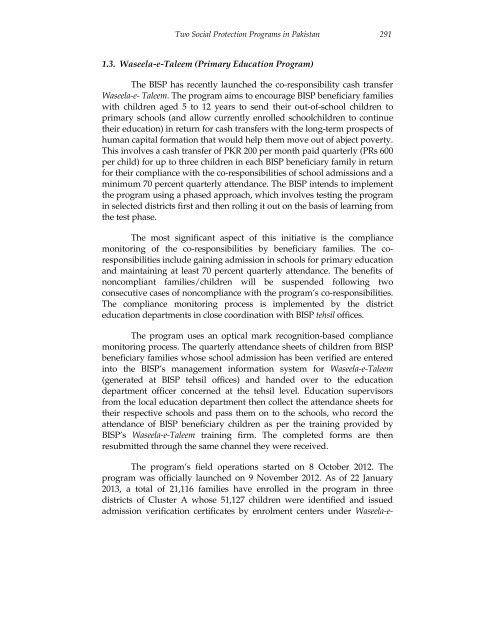Two Social Protection Programs in Pakistan Ijaz Nabi*
Two Social Protection Programs in Pakistan Ijaz Nabi*
Two Social Protection Programs in Pakistan Ijaz Nabi*
- No tags were found...
Create successful ePaper yourself
Turn your PDF publications into a flip-book with our unique Google optimized e-Paper software.
<strong>Two</strong> <strong>Social</strong> <strong>Protection</strong> <strong>Programs</strong> <strong>in</strong> <strong>Pakistan</strong> 2911.3. Waseela-e-Taleem (Primary Education Program)The BISP has recently launched the co-responsibility cash transferWaseela-e- Taleem. The program aims to encourage BISP beneficiary familieswith children aged 5 to 12 years to send their out-of-school children toprimary schools (and allow currently enrolled schoolchildren to cont<strong>in</strong>uetheir education) <strong>in</strong> return for cash transfers with the long-term prospects ofhuman capital formation that would help them move out of abject poverty.This <strong>in</strong>volves a cash transfer of PKR 200 per month paid quarterly (PRs 600per child) for up to three children <strong>in</strong> each BISP beneficiary family <strong>in</strong> returnfor their compliance with the co-responsibilities of school admissions and am<strong>in</strong>imum 70 percent quarterly attendance. The BISP <strong>in</strong>tends to implementthe program us<strong>in</strong>g a phased approach, which <strong>in</strong>volves test<strong>in</strong>g the program<strong>in</strong> selected districts first and then roll<strong>in</strong>g it out on the basis of learn<strong>in</strong>g fromthe test phase.The most significant aspect of this <strong>in</strong>itiative is the compliancemonitor<strong>in</strong>g of the co-responsibilities by beneficiary families. The coresponsibilities<strong>in</strong>clude ga<strong>in</strong><strong>in</strong>g admission <strong>in</strong> schools for primary educationand ma<strong>in</strong>ta<strong>in</strong><strong>in</strong>g at least 70 percent quarterly attendance. The benefits ofnoncompliant families/children will be suspended follow<strong>in</strong>g twoconsecutive cases of noncompliance with the program’s co-responsibilities.The compliance monitor<strong>in</strong>g process is implemented by the districteducation departments <strong>in</strong> close coord<strong>in</strong>ation with BISP tehsil offices.The program uses an optical mark recognition-based compliancemonitor<strong>in</strong>g process. The quarterly attendance sheets of children from BISPbeneficiary families whose school admission has been verified are entered<strong>in</strong>to the BISP’s management <strong>in</strong>formation system for Waseela-e-Taleem(generated at BISP tehsil offices) and handed over to the educationdepartment officer concerned at the tehsil level. Education supervisorsfrom the local education department then collect the attendance sheets fortheir respective schools and pass them on to the schools, who record theattendance of BISP beneficiary children as per the tra<strong>in</strong><strong>in</strong>g provided byBISP’s Waseela-e-Taleem tra<strong>in</strong><strong>in</strong>g firm. The completed forms are thenresubmitted through the same channel they were received.The program’s field operations started on 8 October 2012. Theprogram was officially launched on 9 November 2012. As of 22 January2013, a total of 21,116 families have enrolled <strong>in</strong> the program <strong>in</strong> threedistricts of Cluster A whose 51,127 children were identified and issuedadmission verification certificates by enrolment centers under Waseela-e-
















